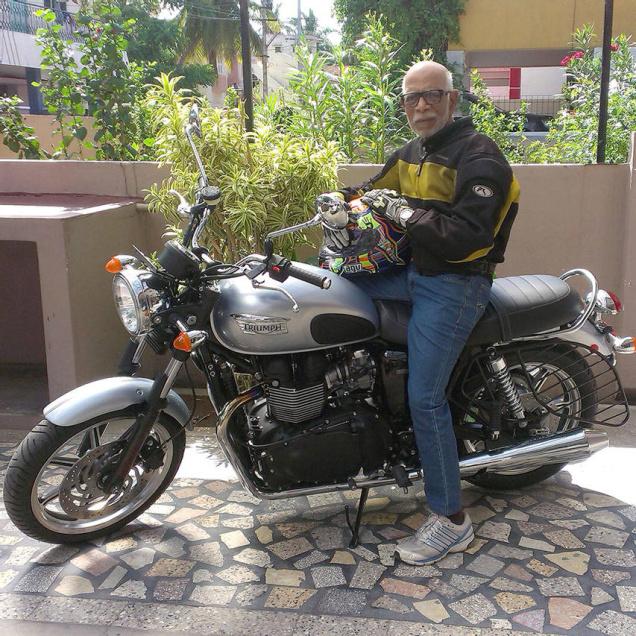
Prince Frederick talks to T.M. Nandakumar about his love for big bikes
German being something that I barely managed to cope with at college, I’m a bit amused to find myself going back to a German dictionary this week. Ironically, to look up the word for triumph. It sounds close to English: noun is der Triump and verb, triumphieren.
The phonetic similarity is not restricted to German. In French, the noun istriomphe and the verb, triompher. In Spanish, it is triunfo and triunfar.
When Triumph set up business in Britain, around 1885, as an exporter of cycles, it was named after one of its two founders, Siegfried Bettmann. The Bettmann trade name was soon replaced by Triumph, as everyone agreed that this word would be easier on lips across the globe, as many people were either using it or using something that sounded almost like it.
The name has stuck, having weathered changes and is continuing to conquer newer lips. As you must be aware, Triumph Motorcycles has entered India with dealerships in place in major cities and the latest launch having taken place in Chennai on June 6.
With the journey of Triumph motorbikes beginning in 1902, when its first motorcycle — essentially a bicycle made to feel powerful by a 1.75 hp engine with a surface carburettor — hit the roads, the brand has had a long innings, riding on the shoulders of different establishments, which include the defunct Triumph Engineering Co. Ltd., and the current Triumph Motorcycles Ltd.
At various stages of its long existence, Triumph bikes have produced many stories that could be counted among the inspiring because they signified, well, the triumph of the spirit over the flesh.
One of these inspirational stories has to do with a biking enthusiast, Basil H. Davies who wrote regularly for a British magazine The Motor Cycle, which ran from 1903 to 1983.
In 1905, Davies was signed up for a novel and daunting exercise: he would test-ride the latest Triumph, one that was fitted with an engine manufactured in-house. His ride would last six consecutive days and his daily chart included having to chalk up 200 miles. The effort was seen as the best way to market the brand and its motorcycles.
In the words of Davies himself, as he writes in The Motor Cycle, following the ride clocking 1,279 miles in six days, taking a different route from Oxford every day: “The machine used was a 1905 3h.p. Triumph with a magneto ignition, and was an absolutely standard pattern. The only special point about it was the spring fork, with which the makers are experimenting for next year.”
As he approaches the fag end of his six-day run, Davies writes, “Only one day is left. Would my luck hold? I did not mistrust the machine, but my misfortunes are proverbial among my motoring friends, and I felt positive I should split a cover or collide with a cow.”
His fears were not unfounded. He was attempting the six-day ride for the second time. He had taken up the challenge the previous week, only to abandon it on the fifth day.
The front down tubes had broken down. The engine parts had also registered considerable wear and tear, though that was not the reason for the failed attempt. Davies succeeded the second time around, and it is reported that during the course of this successful week he had to strip the engine down a few times to fit in new valves. Following this, Triumph is said to have got in touch with a metallurgist and the quality of its bikes improved considerably.
Another inspiring story, in my opinion, happened this week. It was on June 10, when the Triumph showroom on Ethiraj Salai was visited by an interesting customer. T.M. Nandakumar, a medical practitioner from Krishnagiri, was there to take delivery of his Bonneville. The sprightly 76-year-old doctor started from the showroom at 7.30 a.m., rode all the way to Krishnagiri in four hours, whch included a 30-minute halt along the way, at Walajapet.
Only around a month ago, he had had a bad fall from his 1969 Bullet, while riding alone to his farm, around 8 km from Krishnagiri.
“I fell into a ditch and sustained three fractures on the right side of my rib cage,” recalls Nandakumar, who has evidently recovered fast to be able to take home his 865 cc dream machine. “I love British vehicles. In the 1970s, I had a 1954 Triumph Thunderbird,” Nandakumar explains his decision to go in for a Triumph machine now.
The doctor, who belongs to the 1959 batch at Stanley Medical College, is a key member of Wheeled Wanderers, a biking group from Krishnagiri. Consisting mostly of twenty-year-olds, some of them from Hosur, the group does long rides, which include trips to Munnar, Kodaikanal, Ooty and Meghamalai.
Over the years, Nandakumar has had various bikes, including a Matchless, a Norton, many Bullets and a Rajdoot.
“Now, I have a Suzuki Bandit 1250S, a 1969 Bullet, a 1988 Yamaha RX-100, a Honda Dio, which I use for regular rides around the town, and, of course, the Bonneville.”
source: http://www.thehindu.com / The Hindu / Home> Features> MetroPlus / by Prince Frederick / Chennai – June 11th, 2014